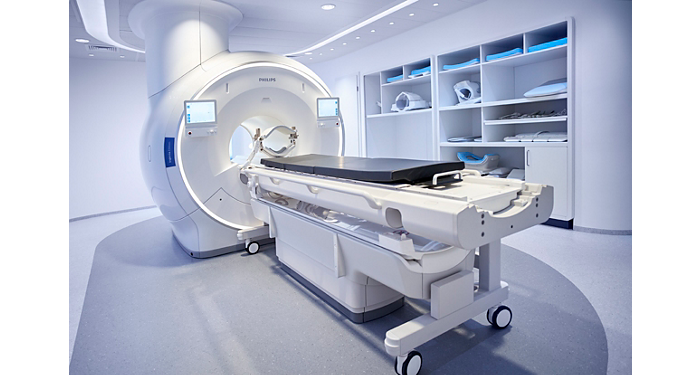Removing as much of a brain tumor as possible during initial neurosurgery can make a critical difference in the prevention of recurrence and the survival rates. At the same time, surgeons want to reduce the chance of damage to vital areas. Due to brain shift, it can be difficult to determine the tumor margins during surgery. With intra-operative MRI, surgeons have on-the-spot access to MR images to visualize the extent of tumor resection and update the surgical plan if necessary. The Philips MR-OR solution provides fast and smooth patient transfer between the OR and connected MR room for intra-operative imaging. This material is not for distribution/use in the USA
Save precious time when making critical decisions
The heart of the latest Philips MR-OR intra-operative neurosurgery solution is a 1.5T or 3.0T Ingenia MR system. It occupies a normal diagnostic MR room that can be directly connected to one or two operating rooms. During a tumor resection procedure, the patient can be moved smoothly, straight to the MR scanner just a few feet away. Transfer times are short, and the MR images can be acquired quickly. This helps the surgical team to make critical decisions right away. If needed, several intra-operative MR exams can be done during the same surgery. MR-OR provides surgeons with up-to-date information on the outcomes of the procedure to share with patients and their families immediately after surgery, and reduces the anxiety of waiting several days for the results to be available.
“The clear benefit is that in cases where the MR-OR setup helps to visualize an incomplete resection, we can immediately address the issue using updated navigation data and thus avoid a second surgery. In addition, the final intra-operative MR replaces the post-operative one that we used to perform.”
Dr. Conor Mallucci
Neurosurgeon, Alder Hey Children’s Hospital, Liverpool, UK

The MR-OR setup at the Oslo University Hospital, Norway. This MR operating room was installed in 2014 and features an Ingenia 1.5T MR-OR system.

Watch the video: This short video illustrates the workflow in a triple-room MR-OR.
Cost-effective solution with high MR utilization
The Philips MR-OR solution places the MR system in its own room, separated from the OR by sliding doors to maintain the OR sterility measures. In addition to standard front docking, the Philips MR-OR solution also features a rear-docking capability. That means you can connect not just one, but two or more ORs to the MR room to increase equipment utilization. Each room is a separate entity that can be used fully independently. In between intra-operative procedures, the MR system can be used for normal diagnostic imaging.
Improved care for neurosurgery patients
“For us, it’s a consideration of patient care,” says Lisa Scarpace, Clinical Coordinator iMRI at the Henry Ford Hospital in Detroit, USA. “When after surgery it turns out that a little bit of tumor is left, patients may need extensive radiation or chemotherapy, or sometimes a patient needs to be taken back to surgery a second time within the same week. MR-OR helps us monitor the extent of resection, that is a big advantage.”
For more information
Read an article about the implementation of MR-OR in the Henry Ford Hospital, Detroit, USA.




